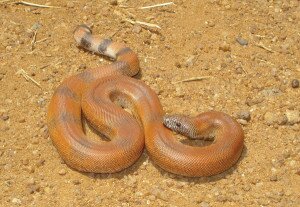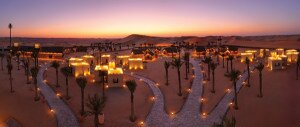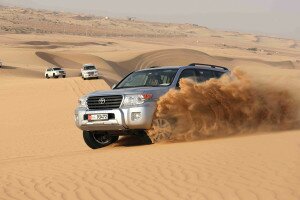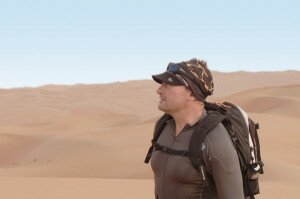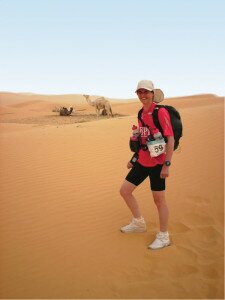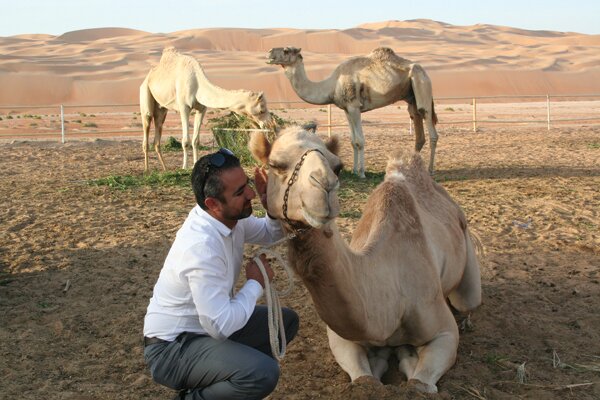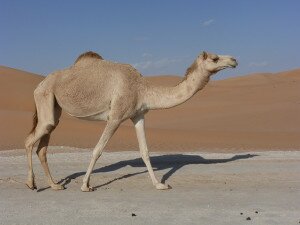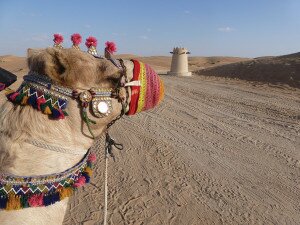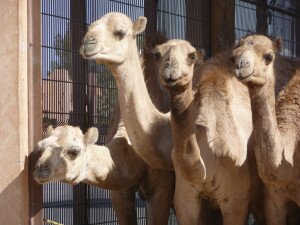The original inhabitants of the Arabian Desert used the stars to navigate the dunes. Today it’s all about GPS, but the magic remains. Explore the dunes with the people who know them best
Desert drives
Abu Dhabi emirate is home to Liwa Desert, the northwestern part of the world’s largest sand desert – the so-called empty quarter, or Rub al Khali in Arabic. It covers over 650,000sq km – that’s bigger than France – and runs from the UAE across Saudi Arabia,
Oman and Yemen.
Sand dunes stretch from the Arabian Gulf coast to the Hajar mountains on the UAE/Oman border.
Tel Moreeb, or ‘scary dune’, is one of Liwa’s greatest landmarks. It’s one of the highest sand hills in the world at 120m tall and 1,600m long.
In this dramatic landscape, even Google has to resort to unusual methods to update its records. Thanks to Raffia the camel, who carries a Google Street View Cam on her back, you can explore Liwa Desert on Google Maps from the comfort of your sand-free sofa.
Joining an off-road club is one of the best ways to learn how to drive in the desert. Members will give tips on driving safely, where to buy equipment and the best areas to go off-road.
Eyad Harb, an Abu Dhabi-based IT operations manager from Jordan, has been driving in the desert for six years. He says, “When I moved to this country I wanted to use my 4×4, so I joined a club. It was exciting to learn how to drive in challenging terrain.
“You should always join a club that caters to drivers with various levels of experience,” says Harb. “Don’t trust groups that just drive, regardless of each individual’s experience. They should teach you how to handle your car and how to recover it when stuck.
“Driving in the desert is an extreme sport. If you make a mistake, your car can roll over and you’ll hurt yourself. You have to be responsible. It took me about a year to feel comfortable with desert driving.”
Driving off-road requires a four-wheel drive vehicle, but not any 4×4 will do. Your car should be high enough to stay clear of the sand – one of the reasons why saloons are not suitable. It should also have a powerful engine, and built-in recovery points – such as hooks at the front and back – in case you need to be towed out of the sand when stuck.
Off-roaders can also be recognised by a high flagpole on their car, essential for spotting one another in the dunes.
Popular brands include the Jeep Wrangler, Toyota FJ Cruiser and Nissan’s Xterra, Patrol and Pathfinder. Hotels and adventure companies commonly use Toyota Land Cruisers, as they have space for many people and are powerful, but usually only drive on easy, well-known desert safari routes. Other cars, such as Land Rovers or the Nissan Armada, are suitable for routes on flat sand, but not for dune bashing because their engines are not powerful enough and the body of the car is too low.
Leon Karakouzian, a HR administrator from Armenia, has 12 years experience driving in the desert.
“You need a powerful engine – a minimum of six cylinders to avoid getting stuck in the sand,” he explains. “A small engine, such as the four-cylinder in the Honda CR-V, can only do easy trips.”
Once in the desert, deflate your tyres before driving on sand. This increases their surface area, reducing your chance of getting stuck. A standard rule is to deflate them two thirds down from your car’s recommended highway pressure.
There are different types of sand with different degrees of softness. Karakouzian tells us that driving in Liwa is the most challenging because of the soft terrain. The softer the sand, the more you need to deflate your tyres. You might need to go as low as 10 psi – a pressure gauge will help you monitor this. Buy one for AED 199 from car garages or www.tech-gear.com
Karakouzian adds, “It’s not safe to go into the desert alone, especially if you have never done it before. Even experienced drivers don’t drive with fewer than three cars, as even two can get stuck.
“There are hidden dangers in the desert, such as wells, especially near farms. They can be covered by sand or wooden planks. Don’t drive too close to farms and stay with people who know the area.
“As with any other sport, the more you practise, the better you become and the less dangerous it is. But it’s important to be responsible.”
To avoid damaging the eco-system, UAE off-roaders follow a series of rules to reduce their impact on nature. Drive on existing tracks, as seeds, bulbs and wildlife might lie on or just below the surface elsewhere, and avoid driving over ground vegetation. Experienced off-roaders often find themselves picking up after careless weekenders so be sure to take your litter home.
Keen to try it? Join a driving club such as UAE Off-Roaders www.uaeoffroaders.com or Oryx 4×4 www.meetup.com/oryx4x4.
If you want to watch extreme desert driving from a safe distance, mark your diary for the Abu Dhabi Desert Challenge, 26th March-2nd April. For more information contact: 04 296 1122 [email protected] www.abudhabidesertchallenge.com
Night neighbours
Animals mostly come out at night when it is cooler, so watch out for gazelles, rabbits, foxes, snakes, scorpions and lizards, such as the protected spiny-tailed lizard.
Avoid walking in clumps of grass and wear closed shoes. Before putting a hand into a dark or cool area such as a box, bang and kick it, as these animals do not like vibrations.
Most reptiles and insects found in the UAE are not venomous, but assume they are and leave them alone.
Should you find yourself face to face with a snake, such as the harmless 20cm thread snake, give it space or a means to escape.
Other non-venomous reptiles found in the emirate include the sand boa – which can reach up to 60cm – and the leaf-nosed snake – up to 45cm.
Venomous snakes include the sand viper, saw-scaled viper and the Arabian rear-fang snake.
As scorpions go, the most common is the buthacus, which is mostly yellow with a black tail and venomous sting. It can reach 75mm.
Fatalities are rare, but a scorpion or snakebite needs immediate medical attention. Clean the wound and isolate it by binding each side of the bite with a bandage. Apply an ice pack or iced water to the wound and head to a hospital immediately. If you can, carefully capture the scorpion or snake and take it with you to hospital, or take a picture to help doctors identify what bit you.
Three to try: desert resorts
Tilal Liwa Hotel
This resort on the edge of Rub Al Khali, 175km from Abu Dhabi, is offering families with two children under 12 a promotional price of AED 599 per night in a superior room. Includes breakfast, free meals for children under six, a 50 per cent discount for children aged six to 12, a free dinner for two adults and a 20 per cent discount on other meals and drinks. As part of the offer, guests are also entitled to a free ten-minute camel ride (usually AED 40) and 30-minute quad-biking experience (usually AED 150), plus 20 per cent off massages and beauty treatments. For more information contact: 02 894 6111 [email protected] www.tilalliwa.danathotels.com
Arabian Nights Village
This Arabic-themed resort is in the Al Khatim Desert – 110km from Abu Dhabi. The experience starts at 2pm, with bus pick-up from Khalifa Park. Activities include sand surfing, camel riding, henna painting and dune bashing – for children seven years and older – and a barbeque dinner with a live oud player and belly dancer. Drop off in Abu Dhabi at 8.30pm. Adults AED 300, children six-12 AED 200. All the above but with overnight stay, breakfast and pool access starts from AED 1,500 for two people in a standard room, up to AED 4,500 for six people in a tower suite. For more information contact: 02 676 9990 [email protected] www.arabiannightsvillage.com
Qasr Al Sarab Desert Resort by Anantara
Spend Valentine’s Day at this luxury resort in the Liwa Desert – rumoured to have been used as a set on Star Wars: Episode VII. Rooms for two start at AED 2,150++ per night, including breakfast. The resort is 200km from Abu Dhabi. For more information check out our ‘Sisters are doing it for themselves’ feature.
Three to try: desert excursions
Desert safari companies offer dune bashing on the way to a Bedouin camp. Once there, you can try Arabic coffee and dates, camel riding, henna painting and sand boarding, and end the day with a barbeque in a majlis – a lounge with traditional Arabic seating.
Arabian Adventures
Pick up from any hotel in Abu Dhabi, minimum of two participants. Includes 30 minutes dune bashing, a dedicated photo-op stop, a 15-minute camel ride and dinner in the camp. 3.30pm-9.30pm. Adults AED 315, children from five-14 AED 290, under fives free. For more information contact: 02 691 1711 [email protected]
www.arabian-adventures.com
Emirates Tours
Pick up from any hotel or mall in Abu Dhabi, no minimum number of participants. Includes 45-minutes dune bashing and a belly dancing show during a barbeque. 3pm-9.30pm. Adults AED 290, children from four-12 AED 200, under fours free. For more information contact: 02 491 2929 [email protected] www.eatours.ae
Phoenix Tourism
Pick up from anywhere in Abu Dhabi, no minimum number of participants. Includes 25-minutes dune bashing and a 15-minute visit to a camel farm. Activities include a 10-minute falcon show, quad biking, a photo opportunity in Arabic dresses and an Al Ayyala performance – a traditional Emirati dance. 3pm-9.30pm. Adults AED 250, children three-11 AED 200, under threes free. For more information contact: 050 664 1814 [email protected] www.phoenixtourism.ae
Liwa Challenge Master Trek
The inaugural edition of the desert endurance race Liwa Challenge Master Trek will be from 9th to 12th February in the Liwa Desert.
Forty-five athletes from all over the world – including France, Italy, England, Switzerland, Finland and Guyana, South America – will tackle a 100km or 200km route through the sand, navigating with a GPS.
They will be self-sufficient as they traverse the desert, carrying food and sleeping gear. Racers can refill their water supplies and receive medical support at nine checkpoints, spaced out every 25km.
Both races will start from Tel Moreeb summit on 9th February, as confirmed by the organiser. The first athletes from the 100km course are expected to finish at the base of the dune approximately 20 hours later, while the winner of the 200km track might complete the trek in 36 to 40 hours. The maximum time allowed to complete either course is 75 hours.
A monitoring system is set up on the ground, so the progress of every runner can be followed on the race’s website.
Michel Casals, the race’s managing director and an experienced former runner, says, “It’s easy to access Tel Moreeb as there is a Tarmac road leading to it 22km from the main road to Liwa. You can drive there in any type of car.
“Spectators are welcome at the starting point 10am to 11am on 9th February to cheer on the athletes, or at the finishing line to greet the winners. The first athletes should arrive on 10th February from 6am.”
Each athlete will decide whether or not they will sleep or stop en route.
“Usually no one stops for the first 24 hours,” Casals says, “but from then on it’s a personal decision. This is not a race for beginners. All participants are experienced long-distance runners. It’s not easy to run on sand so many will walk for up to 75 per cent of the track.
“We often say ‘I did it because I did not know it was impossible’ and this is particularly true with this type of challenge. Your body is stronger than you think. This race isn’t only for a selected elite. If you are willing to train in endurance running, you can do it too.”
For more information and the full schedule contact: [email protected] www.liwachallenge.com
The desert wanderer
Who would be mad enough to take on such a Herculean task? Turns out Laurent Locke, a British top-level runner and international representative of the Liwa Challenge, is.
“I am 49 and in 2002 I did my first ultra run – the ‘Marathon des Sables’, billed at the ‘toughest footrace on Earth’. I ran it in remembrance of my father, who fought World War II in the Sahara with a special forces unit called Popski’s Private Army.
“It’s my first time in the Liwa Desert and as far as I am aware, this is the first time in the world that a race is run 100 per cent on sand.
“I foolishly signed up for the 200km course, and I hope to complete it in 60 hours. On dunes, you are lucky to run 3km per hour.
“I want to do 80 to 100km on day one when I am at my freshest, so I know I have a margin for the next day. Then I am going to stop and sleep.
“Choosing the right food to bring is essential. You need plenty of calories for not much weight. I don’t bring power bars because they are just sugar, not ideal for endurance as they give you a boost of energy that wears off quickly.
“Peanut butter is ideal as it has sugars, fats and nuts. If you like it, you don’t get tired of it. Once I met a guy who planned to do a race pretty much only on Nutella, but then he was borrowing food from everyone he met.
“I will bring a stove to boil water. I’d rather carry a bit more weight and have something hot to eat, especially on a cold desert night.
“It’s key to drink regularly, because by sweating you are losing a lot of fluids. On a desert run, you can drink up to nine litres of water a day. Between checkpoints you can carry up to four litres of water, which is heavy, but if you bring less than three litres you risk becoming dehydrated. If dehydrated, you stop being thirsty and when you try to drink, your body rejects it and you get sick, which dehydrates you even more.
“Everyone has different running shoes. I use Hoka One One shoes because they are light and have a wider sole. Some people use gaiters, or waterproof covers, to keep the sand out, but the downside is that your feet can get sweaty and you get blisters. I just regularly empty sand from my shoes.
“Despite the physical suffering, the desert is an amazing place and I think the experience of being a small creature in such vastness brings you much closer to Earth. It’s a unique spiritual experience.
“The feeling of crossing the finish line of the first edition of the Liwa Challenge will undoubtedly be a highlight of my 2015.”
The remoteness warrior
Sharon Gayter, an English ultra-runner and sport science graduate, has been billed by Locke as a potential winner.
Gayter tells us, “Heat is the biggest problem because there is no shade until you get to a checkpoint. The checkpoints here are also further apart compared to other races, so you have to carry enough water to get you to the next one.
“Just before Christmas I went to South Africa to do a six-day race to get used to the heat.
“A few years ago, when I was preparing for a challenge in Libya, I went into an environmental chamber – an enclosure used to test the effects of specified environmental conditions on people. We put it up to the expected temperature in Libya, I put on my backpack and ran on the treadmill to measure my sweat rate, to find out how much fluid I needed to bring.
“If you are running in heat, you should wear a hat and sacrifice some of your water to keep it wet, as this will keep you cooler.
“I hope I will finish the 200km race in under 48 hours, even though I know this will be challenging because it’s on soft sand so you sink a lot. This course has never been done before so you have no benchmarks. The unknown is part of the fun, though.
“I will not sleep unless I have to. I didn’t sleep when I did the Ocean Floor Race in the Egyptian Sahara, which was approximately 260km. It took me 50 hours.
“To stay awake, the key is to keep moving. Your heart rate stays high, which stops you from feeling sleepy.
“My survival kit is minimal. The more weight you carry, the more it slows you down. You are required to bring 6,000 calories worth of food, even though I am a small eater when I run so I will probably eat half of that. I will have some trail mix, chia seeds and nuts, a few flapjacks – oatmeal bars – and sports drinks. The desert gets cold at night so I am bringing trousers, a hat and gloves.
“I am wearing one and a half size bigger shoes than what I would wear for a normal marathon because your feet swell in the heat. On top of that I make my own gaiters that I glue onto my shoes. If you keep sand out of your shoes you won’t get blisters.
“What people don’t understand about these races is how remote they are. I like to run on my own. The enjoyment comes from being out there and navigating your way through somewhere you have never been before. If I come last and enjoy it, I will still have achieved my goal.”
Camels 101
The Arabian camel, also known as the dromedary or the single-humped camel, is a large mammal that was an essential companion to the region’s Bedouins for thousands of years. We meet Amer Braik, a Jordanian camel trainer and director of environmental and cultural activities at Qasr Al Sarab Desert Resort by Anantara.
How do you train a camel?
Camels can be moody, and if you startle them or force them to do something they don’t want to do, they can become aggressive. You need to be friendly and patient, but also firm.
In the UAE, camels up to three years old are mostly used for racing. They can live up to 50 years so after their racing days are over, many are trained to wear a saddle and carry people. It’s not easy at the beginning, as they are not used to having anything on their back apart from the small robot jockeys used on the racetrack.
You need to train them for five hours a day for a month to teach them commands such as stand up and sit down. You also have to give them plenty of time to roam free in the farm otherwise they become agitated.
How many types of camels live in the UAE?
Only the dromedary camel. If they are black, they are likely to be from Saudi Arabia; brown ones originate from the UAE, Oman, Pakistan and Australia; white camels are usually from Sudan, Egypt or Jordan.
Are camels friendly?
Generally yes, but every camel has a different personality. You have to be good to them, as camels have an excellent memory and they never forget how you treated them. If you visit a camel farm, they might be scared initially. As soon as they realise that you are not a threat, they will come over and let you pet them.
How should they be approached?
Don’t make any loud noises, such as shouting or whistling. Keep a distance at the beginning and try to get closer at a slow, steady pace. Make them feel safe, and they will accept your presence. Don’t approach mothers with new babies, as they tend to be more nervous.
If we see a camel on its own on the side of a road, is it lost?
There are no wild camels in the UAE. All camels belong to someone, and UAE owners let their camels roam free as it’s good for them to explore. Camels will always go back to their owners because they know there is food and water there. Camels are marked with a tattoo or if they are more valuable, a microchip. Racing camels’ microchips contain information about their career, such as how many metres they ran, their average speed and family history.
Five places to see a camel in Abu Dhabi
In Abu Dhabi:
- Heritage Village, breakwater,opposite Marina Mall.
Take a picture with the resident camel. Sat-Thu 9am-5pm, Fri 3.30pm-9pm. Free entry. 02 681 4455 [email protected] - Emirates Park Zoo, off E11, Al Bahyah.
You can pet camels in the domestic area. Daily 9am-9pm. Adults AED 25, children aged three-five AED 10; under twos free. 02 563 [email protected] www.emiratesparkzoo.com - Qasr Al Hosn Festival
This annual celebration of Emirati heritage will be hosted 11th-21st Feb. 02 697 6472 [email protected] www.qasralhosnfestival.ae
In Al Ain:
- Al Ain Zoo, Nahyan the 1st Street.
Visitors can pet camels in the children’s zoo area. Sat-Wed 9am-8pm, Thu-Fri 9am-9pm. Adult AED 20, children aged three-12 AED 10; under threes free. 03 799 2000 [email protected] www.alainzoo.ae - The camel souk, Street 137, behind Bawadi Mall, in the direction of Meyzad. A cattle market featuring baby camels, goats and sheep. Daily 7am-sunset. Free entry.
Laura Volpi


















